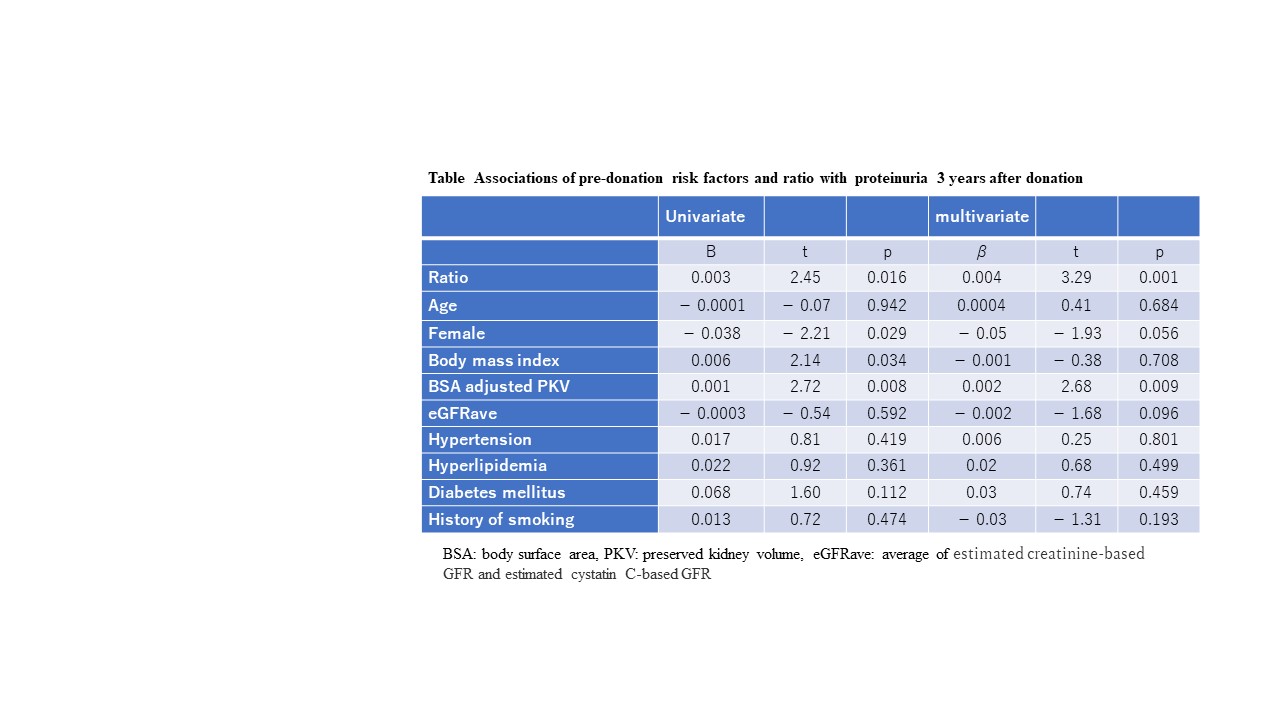Association of Change in Kidney Volume with Proteinuria After Donation
1Masuko Memorial Hospital, Nagoya, Japan, 2Japanese Red Cross Aichi Medical Center Nagoya Daini Hospital, Nagoya, Japan
Meeting: 2022 American Transplant Congress
Abstract number: 1035
Keywords: Donation, Kidney transplantation, Proteinuria
Topic: Clinical Science » Kidney » 40 - Kidney Living Donor: Other
Session Information
Session Time: 7:00pm-8:00pm
 Presentation Time: 7:00pm-8:00pm
Presentation Time: 7:00pm-8:00pm
Location: Hynes Halls C & D
*Purpose: In living kidney transplantation, the risk of end-stage kidney disease in kidney donors is crucial, however, it still remains to be resolved. Any useful marker to predict kidney outcome would be needed for the safety of donors.
*Methods: This retrospective study was conducted at Nagoya Daini Red Cross Hospital, Japan to confirm whether an increase in preserved kidney volume (PKV) was a predict marker of proteinuria. Abdominal computed tomography (CT) scans were performed before and 1 year after donation to calculate percent changes in PKV. Ratio was defined as % changes in PKV.A ratio of PKV before and after donation was measured, and the association of it with proteinuria 3 years after donation was analyzed.
*Results: A total of 119 living kidney donors were enrolled with the mean ± SD age of 57.4 ± 10.6 years old. Of these, 46.2 % were male, and mean BMI levels were 23.4 kg/m2. The mean BSA adjusted PKV levels were 132.9 cm3/1.73m2, and eGFR levels were 82.9 ml/min/1.73m2. Appropriate 24 % of them took anti-hypertensive drugs, however, blood pressure was well controlled. Patients with DM were found in 4.2 %, and the mean HbA1c were 5.7 %. All of them did not have retinopathy and microalbuminuria. The mean ratio was 19.5 %. (PKV increased by a mean of 19.5 % 1 year after donation ) The median urine protein 3 years after donation was 0.04 g/gCre, and 12.3 % of them showed more than 0.15 g/gCre. There was a positive correlation between eGFR before donation and PKV. (r = 0.61, p < 0.001) Linear regression analyses showed the ratio, and PKV before donation were significantly associated with proteinuria 3 years after donation.
*Conclusions: The ratio and PKV before donation are important factors for proteinuria after donation under the Japanese donor guideline. Further studies will be needed to confirm whether these factors are associated with renal survival after donation.
To cite this abstract in AMA style:
Tsujita M, Uchida K, Morozumi K, Futamura K, Hiramitsu T, Okada M, Narumi S, Goto N, Watarai Y. Association of Change in Kidney Volume with Proteinuria After Donation [abstract]. Am J Transplant. 2022; 22 (suppl 3). https://atcmeetingabstracts.com/abstract/association-of-change-in-kidney-volume-with-proteinuria-after-donation/. Accessed December 11, 2025.« Back to 2022 American Transplant Congress

